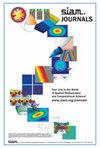The Split Gibbs Sampler Revisited: Improvements to Its Algorithmic Structure and Augmented Target Distribution
IF 2.3
3区 数学
Q3 COMPUTER SCIENCE, ARTIFICIAL INTELLIGENCE
引用次数: 1
Abstract
Developing efficient Bayesian computation algorithms for imaging inverse problems is challenging due to the dimensionality involved and because Bayesian imaging models are often not smooth. Current state-of-the-art methods often address these difficulties by replacing the posterior density with a smooth approximation that is amenable to efficient exploration by using Langevin Markov chain Monte Carlo (MCMC) methods. An alternative approach is based on data augmentation and relaxation, where auxiliary variables are introduced in order to construct an approximate augmented posterior distribution that is amenable to efficient exploration by Gibbs sampling. This paper proposes a new accelerated proximal MCMC method called latent space SK-ROCK (ls SK-ROCK), which tightly combines the benefits of the two aforementioned strategies. Additionally, instead of viewing the augmented posterior distribution as an approximation of the original model, we propose to consider it as a generalisation of this model. Following on from this, we empirically show that there is a range of values for the relaxation parameter for which the accuracy of the model improves, and propose a stochastic optimisation algorithm to automatically identify the optimal amount of relaxation for a given problem. In this regime, ls SK-ROCK converges faster than competing approaches from the state of the art, and also achieves better accuracy since the underlying augmented Bayesian model has a higher Bayesian evidence. The proposed methodology is demonstrated with a range of numerical experiments related to image deblurring and inpainting, as well as with comparisons with alternative approaches from the state of the art. An open-source implementation of the proposed MCMC methods is available from https://github.com/luisvargasmieles/ls-MCMC.对分离式吉布斯采样器的再考察:改进其算法结构和增强目标分布
本文章由计算机程序翻译,如有差异,请以英文原文为准。
求助全文
约1分钟内获得全文
求助全文
来源期刊

SIAM Journal on Imaging Sciences
COMPUTER SCIENCE, ARTIFICIAL INTELLIGENCE-COMPUTER SCIENCE, SOFTWARE ENGINEERING
CiteScore
3.80
自引率
4.80%
发文量
58
审稿时长
>12 weeks
期刊介绍:
SIAM Journal on Imaging Sciences (SIIMS) covers all areas of imaging sciences, broadly interpreted. It includes image formation, image processing, image analysis, image interpretation and understanding, imaging-related machine learning, and inverse problems in imaging; leading to applications to diverse areas in science, medicine, engineering, and other fields. The journal’s scope is meant to be broad enough to include areas now organized under the terms image processing, image analysis, computer graphics, computer vision, visual machine learning, and visualization. Formal approaches, at the level of mathematics and/or computations, as well as state-of-the-art practical results, are expected from manuscripts published in SIIMS. SIIMS is mathematically and computationally based, and offers a unique forum to highlight the commonality of methodology, models, and algorithms among diverse application areas of imaging sciences. SIIMS provides a broad authoritative source for fundamental results in imaging sciences, with a unique combination of mathematics and applications.
SIIMS covers a broad range of areas, including but not limited to image formation, image processing, image analysis, computer graphics, computer vision, visualization, image understanding, pattern analysis, machine intelligence, remote sensing, geoscience, signal processing, medical and biomedical imaging, and seismic imaging. The fundamental mathematical theories addressing imaging problems covered by SIIMS include, but are not limited to, harmonic analysis, partial differential equations, differential geometry, numerical analysis, information theory, learning, optimization, statistics, and probability. Research papers that innovate both in the fundamentals and in the applications are especially welcome. SIIMS focuses on conceptually new ideas, methods, and fundamentals as applied to all aspects of imaging sciences.
 求助内容:
求助内容: 应助结果提醒方式:
应助结果提醒方式:


